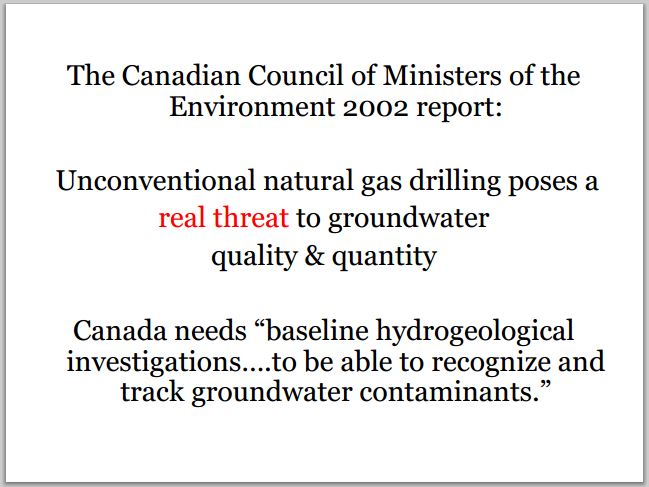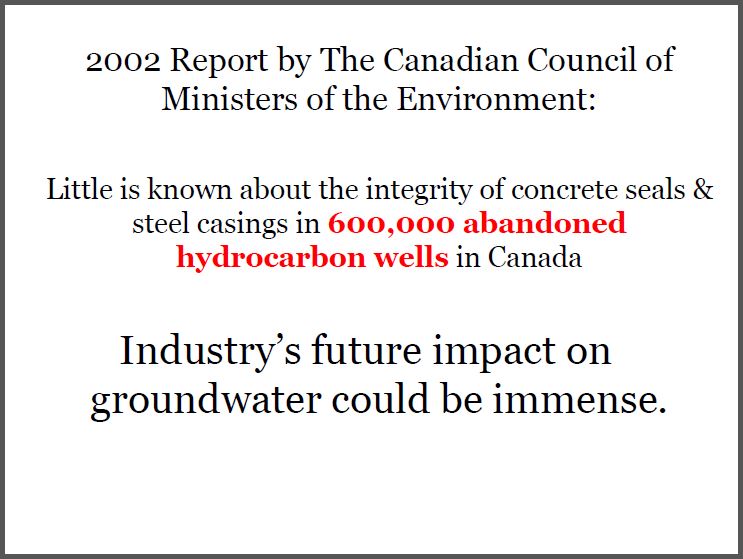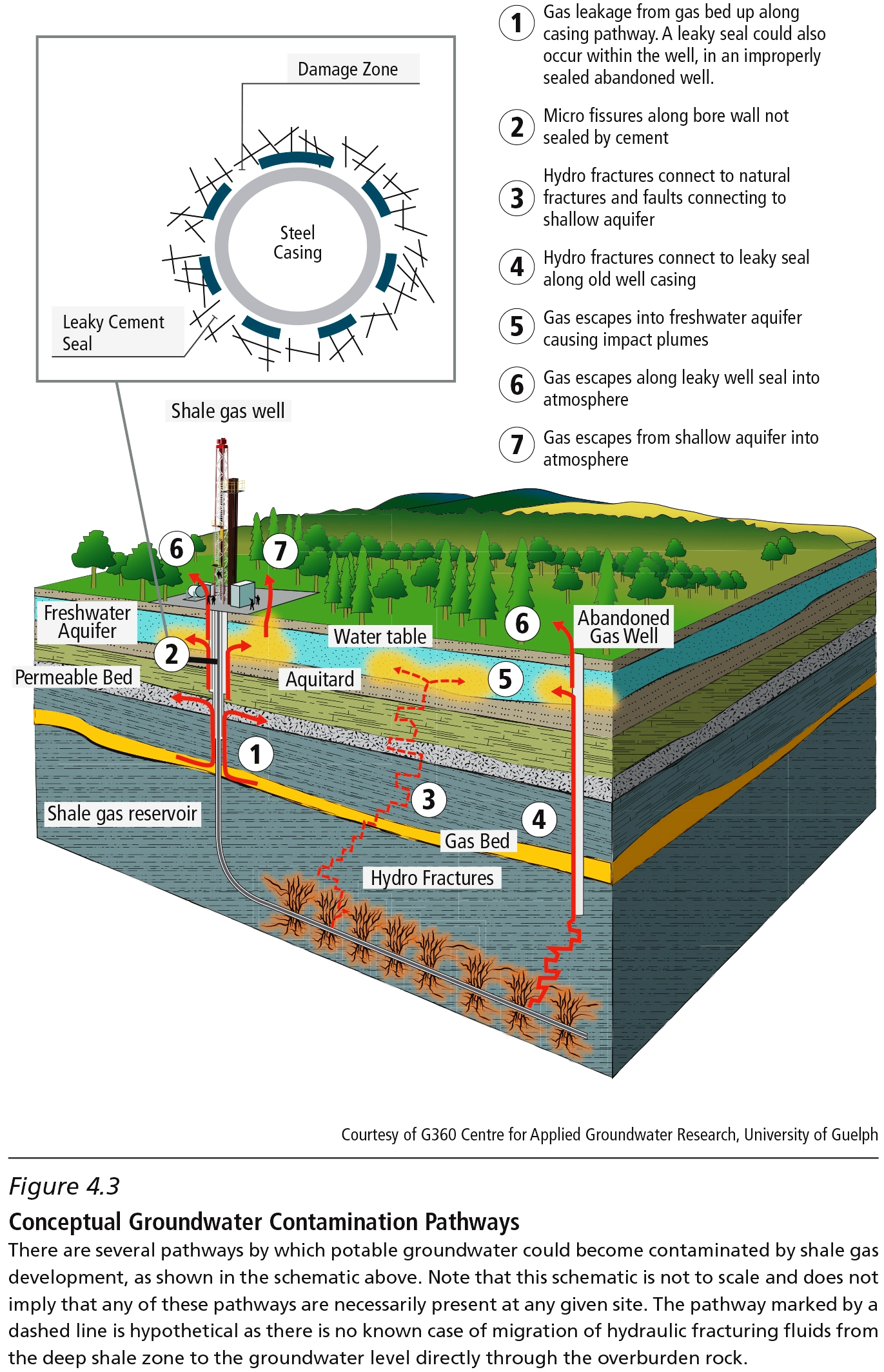Fracking Data Woefully Lacking in Canada, Finds Federal Report by Erika Thorkelson, May 2, 2014, desmogblog.ca
There is simply not enough reliable information to be confident about the environmental impacts of hydraulic fracturing, according to a new report released by the Council of Canadian Academies. The report, commissioned by Environment Canada, takes a broad view of the implications of “fracking,” from possible contamination of land and water to greenhouse gas (GHG) emissions to human health and social impacts. It identified several key areas of concern, particularly that pathways created by leakage of natural gas from “improperly formed, damaged or deteriorated cement seals” may contaminate ground water….
But overall, the report’s key criticism was the utter lack of reliable data on the contentious topic. “In most instances, shale gas extraction has proceeded without sufficient environmental baseline data being collected,” it concludes.
In an interview with CBC during the afternoon call-in show BC Almanac, John Cherry, the University of Guelph adjunct professor who headed up the study, pointed out that when issues do come up, industry has tended to sweep complaints under the rug.
As journalist Andrew Nikiforuk recently reported on The Tyee, a high-profile water contamination case in Alberta against natural gas giant Encana has been met with significant pushback from government. Claimant Jessica Ernst, a former environmental consultant for industry, is suing Encana and the provincial regulator for negligence and a violation of the Charter of Rights and Freedoms, respectively, in the contamination of her groundwater near the hamlet of Rosebud, Alberta.
Recently Alberta Environment sought to have the word ‘contamination’ struck from the lawsuit, as well as any other mention of polluted water wells in the region.
Nikiforuk also reports in many cases landowners who have suffered ill-effects from the fracking process have been made to sign non-disclosure agreements, making it impossible to draw reasonable conclusions about the frequency of problems or study the incidents to make future regulatory improvements.
Responding to statements by British Columbia energy minister Rich Coleman about the safety of fracking, Cherry was unequivocal: “Your minister is wrong,” he said. “There is no reason for government to be confident.”
…
Any realistic understanding of the issue will require a “crash course program of monitoring and research,” Cherry told the CBC. Similar reports decrying the shortage of data and calling for enhanced monitoring appeared recently in the United Kingdom, Germany and Australia. [Emphasis added]
[Refer also to:
Slide from Ernst presentation April 22, 2012, Prince Albert, Saskatchewan (Shale gas and oil, tight gas and coalbed methane are unconventional resources;)
Monitoring was recommended by top Canadian environmental officials 12 years ago. Instead, thousands of unconventional gas wells were fractured in secret above the Base of Groundwater Protection (as the Alberta regulators call it) or into the Fresh Ground Water Zone (as Dr. John Cherry and his panel calls it). Groundwater monitoring isn’t even happening in communities with contamination proven linked to industry (Spirit River, Wetaskiwin, Ponoka, etc). Regulators lie, cover up, close cases with no resolution for harmed families as companies move down the street to frac the next community.
Slide from Ernst presentation March 15, 2012 at Eagle Hill, Alberta
Figure 4.3 above and close up below from Page 72: Environmental Impacts of Shale Gas Extraction in Canada
[“But there is in fact a documented case, and the E.P.A. report that discussed it suggests there may be more. … The E.P.A.’s 1987 report does not discuss the specific pathway that the fracking fluid or gel took to get to Mr. Parsons’ water well in West Virginia or how those fluids moved from a depth of roughly 4,200 feet, where the natural gas well was fracked, to the water well, which was about 400 feet underground. ...
This well was fracked using gas and water, and with far less pressure and water than is commonly used today. … “The evidence is pretty clear that the E.P.A. got it right about this being a clear case of drinking water contamination from fracking,” said Dusty Horwitt, a lawyer…who investigated the Parsons case. …
Mr. Parsons said in a brief interview that he could not comment on the case. Court records indicate that in 1987 he reached a settlement with the drilling company for an undisclosed amount.”
Article excerpts above with emphasis added, from: A Tainted Water Well, and Concern There May Be More by Ian Urbina, August 3, 2011, New York Times
Excerpt below from The New York Times 2011 Drilling Down Documents:
“This is a 1987 report to Congress by the Environmental Protection Agency that deals with waste from the exploration, development and production of oil, natural gas and geothermal energy. It states that hydraulic fracturing, also called fracking, can cause groundwater contamination. It cites as an example a case in which hydraulic fracturing fluids contaminated a water well in West Virginia. The report also describes the difficulties that sealed court settlements created for investigators.”
Cover of the 1987 EPA Report ]






